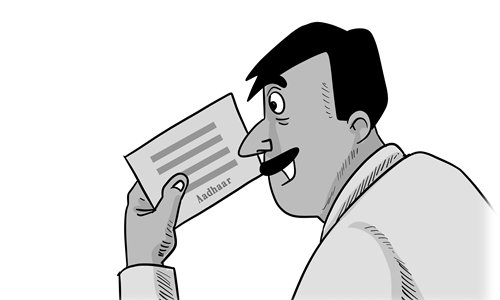HOME >> BUSINESS
India has its unique wisdom in financial development
Source:Global Times Published: 2019/9/4 21:38:40

Illustration: Luo Xuan/GT
In 2016, the Indian government suddenly announced the demonetization of all 500-rupee and 1,000-rupee banknotes, which caused panic in Indian society in the short-term. The drastic move also baffled countries around the world, with the general perception being that the Indian government lacks experience in financial management.
However, the Indian government had its own thinking behind the demonetization. India can work things out in its own manner. In fact, the Indian government has long been plagued by the loose control of regional administration. Given the dozens of different languages used in the country, India was unable to employ a unified identification system. To solve the issue, the Indian government took measures to unify identification documents nationwide. Each identity has a corresponding bank account. The ambitious program is referred to as Aadhaar.
According to the program, everyone must provide facial recognition data, fingerprint data, and iris data to create a bank account that is linked to their identity. The account will allow the government to pay to individuals directly by skipping all intermediate links, thus avoiding India's corruption problems. Yet, things went just as could have been expected. Indians simply didn't buy it. Nearly 600 million Indian people refused to establish such linked accounts due to the complicated process. Under the unique social conditions in India, especially in some rural areas, it was extremely difficult to complete the whole process. Therefore, those with no interest chose to ignore it.
It is against such a backdrop that the demonetization was rolled out. On November 8, 2016, Indian Prime Minister Narendra Modi declared the 500-rupee and 1,000-rupee banknotes invalid from the following day, but said that the banknotes could be deposited at banks or post offices by the end of 2016. In order to deposit cash into the bank, Indians must first have a digital identification number and then open a nationally unified bank account. Thus, in less than half a month, the country with a population of more than one billion completed the popularization of digital identity.
At present, almost all services in India require Aadhaar verification. For instance, in Tamil Nadu, the distribution of supplies must be through Aadhaar. Due to its biometric data linkage, Aadhaar must be used in court services. Opening a bank account and conducting transactions over 50,000 rupees ($695) must also go through Aadhaar. Holders of existing accounts must submit their Aadhaar information or their accounts will be deemed invalid. With the implementation of the program, services like education and health care have also been gradually incorporated into Aadhaar. In early 2017, India accomplished the critical step of unifying the national market, meaning Modi had solved the problem of unification that had plagued the country for decades.
Then, it is on this foundation that an electronic payment system more advanced than China's came into being. The Reserve Bank of India released an electronic payment system, under which all nationwide, third-party payments can be made. Unlike WeChat Pay and Alipay in China, all third-party payments in India must be linked to its central bank's electronic payment system. In other words, India now has stronger control over third-party payments than China does over its own. As a result, a large number of third-party payment companies have emerged in India. While their development is not as advanced as their Chinese peers at present, India will likely find a unique path that suits its national conditions in the future.
Undoubtedly, Modi has his own, unique political wisdom. China only accomplished the popularization of identification cards 30 years ago, and until today China still hasn't been able to collect fingerprint data, iris data or facial recognition data on a large scale.
It is true that the introduction of demonetization has had a certain impact on the Indian economy, and it is impossible for demonetization to completely address problems like black-money circulation, corruption and administrative inefficiency. But just as Modi said, Aadhaar is India's ticket to the future - a universal, easy-to-use identification system that will reduce this country's endemic corruption and help bring even the most illiterate into the digital age. Although there will still be twists and turns on its way to becoming a major power, New Delhi is slowly transforming by finding a development path of its own. There are undoubtedly many aspects of India's situation that are worth learning from and thinking about.
The article was compiled based on a report by Beijing-based private strategic think tank Anbound. bizopinion@globaltimes.com.cn
Posted in: INSIDER'S EYE